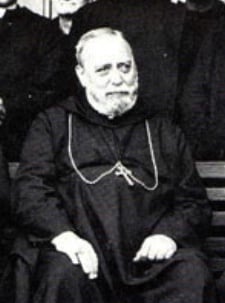Search
-
The Coming of Benedictines to Morris County (1910–1965)
The election of Fr. Ernest Helmstetter as the third abbot of St. Mary’s Abbey on January 4, 1910, signaled the start of a new era. A native of Newark’s Down Neck neighborhood and educated at St. Benedict’s, St. Vincent’s, and the newly independent St. Mary’s, Ernest had been a monk since 1879 and held various leadership roles under Abbots James and Hilary. Upon his election, he brought energetic leadership, enhancing the academic stature of St. Benedict’s in Newark and St. Anselm in Manchester, expanding parish work, and boosting vocations. He served as President of the American Cassinese Congregation for a record 28 years and was honored by Pope Pius IX for his service.
The most significant development during his abbacy was the 1927 independence of St. Anselm Abbey in New Hampshire. While ties between Newark and Manchester remained friendly, it was natural for vocations and leadership to eventually become regionally distinct. When St. Anselm became independent, about thirty monks transferred their stability to Manchester, reducing St. Mary’s community to 71 members. Yet within a decade, numbers rose again to 85, affirming Abbot Ernest’s strength as a leader. Abbot Ernest Helmstetter,OSBParallel to this, Abbot Ernest guided the Newark community in seeking a new house of studies for its young monks as reliance on Manchester diminished. Two sites were considered—Darlington in Mahwah and Delbarton in Morristown. Oral tradition credits the decisive influence of elderly Father Ambrose Huebner and a few Benedictine medals discreetly buried on the Delbarton estate. On August 18, 1925, St. Mary’s Abbey purchased nearly 400 acres of the former Kountze estate, once a summer retreat of financier Luther Kountze. The estate included a stone mansion, extensive outbuildings, and an Italian garden, all in disrepair but rich with promise.
Abbot Ernest Helmstetter,OSBParallel to this, Abbot Ernest guided the Newark community in seeking a new house of studies for its young monks as reliance on Manchester diminished. Two sites were considered—Darlington in Mahwah and Delbarton in Morristown. Oral tradition credits the decisive influence of elderly Father Ambrose Huebner and a few Benedictine medals discreetly buried on the Delbarton estate. On August 18, 1925, St. Mary’s Abbey purchased nearly 400 acres of the former Kountze estate, once a summer retreat of financier Luther Kountze. The estate included a stone mansion, extensive outbuildings, and an Italian garden, all in disrepair but rich with promise. The Kountze Family at "Delbarton"The first monks arrived in summer 1926: Fr. Edward Bill, Fr. Norbert Hink (an artist), and Fr. Ambrose, soon joined by Brother Aloysius Hutten, a nurse and master carpenter. Over time, they adapted the mansion for monastic use—its dining room became the refectory and the music room a chapel. Monks farmed the land, raised animals, and renovated buildings with help from lay craftsmen. In 1927, Abbot Ernest formally inaugurated the monastery and school of theology at Delbarton, naming Fr. Henry Becker its first prior. Young monks spent summers at Delbarton; from the early 1930s, college formation took place there year-round.
The Kountze Family at "Delbarton"The first monks arrived in summer 1926: Fr. Edward Bill, Fr. Norbert Hink (an artist), and Fr. Ambrose, soon joined by Brother Aloysius Hutten, a nurse and master carpenter. Over time, they adapted the mansion for monastic use—its dining room became the refectory and the music room a chapel. Monks farmed the land, raised animals, and renovated buildings with help from lay craftsmen. In 1927, Abbot Ernest formally inaugurated the monastery and school of theology at Delbarton, naming Fr. Henry Becker its first prior. Young monks spent summers at Delbarton; from the early 1930s, college formation took place there year-round.
